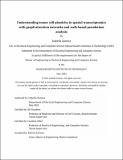Understanding tumor cell plasticity in spatial transcriptomics with graph attention networks and walk-based pseudotime analysis
Author(s)
Zamora, Izabella
DownloadThesis PDF (12.20Mb)
Advisor
Hacohen, Nir
Uhler, Caroline
Terms of use
Metadata
Show full item recordAbstract
Tumor cell plasticity in cancer is a key driver in tumor progression, heterogeneity, metastasis, and treatment resistance. Tumor cells change states from the conventionally easier to treat epithelial state to the more resistant mesenchymal state. Understanding the transition dynamics of these states and the extrinsic factors influencing them is crucial for improving therapeutic strategies and patient outcomes. Utilizing spatial transcriptomics extrinsic driving factors of plasticity can be probed. We introduce PlastiNet, which uses a graphical attention-based network to create a spatial aware embedding. The utility of our approach is validated in model systems, specifically in the brain and colon, where it successfully identifies biologically relevant neighborhoods and maps differentiation pathways. When applied to pancreatic ductal adenocarcinoma (PDAC), distinct, conserved neighborhoods within the tissue, including diverse immune and cancer clusters. By estimating a differentiation path from epithelial to mesenchymal-like cells, we can identify intermediate states despite a limited set of tumor marker genes. This cellular differentiation path shows enrichment and depletion of certain cell types within local neighborhoods aligning with known correlations, and by leveraging inferred ligand-receptor interactions, we can pinpoint potential drivers of plasticity to test in vitro. PlastiNet effectively generates hypotheses directly from patient-derived spatial transcriptomics samples, offering insights into the cellular mechanisms driving tumor plasticity.
Date issued
2024-05Department
Massachusetts Institute of Technology. Department of Electrical Engineering and Computer SciencePublisher
Massachusetts Institute of Technology